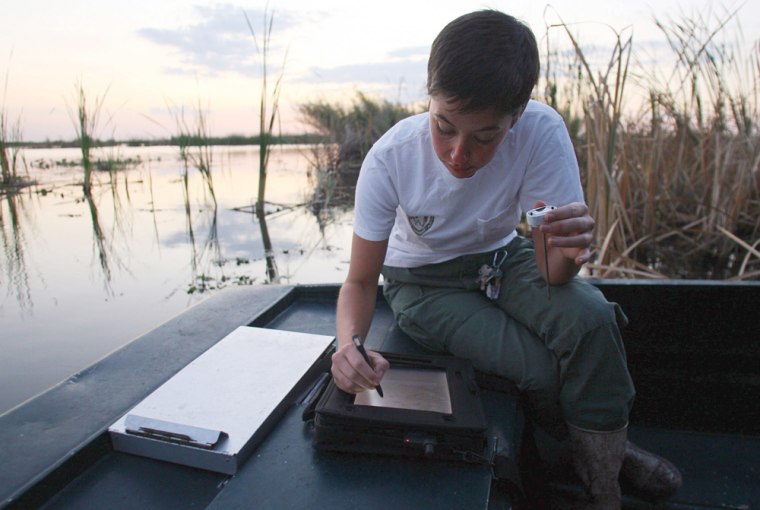To the unaided eye, the swamp seems to sleep at night. But hit it with a spotlight and alligators suddenly appear everywhere, their bulbous red eyes glowing on the water’s black surface.
The biologists begin to count. In three hours, from just a pair of airboats, they find 754 gators in one small section of Lake Okeechobee, one of Florida’s most concentrated gator habitats.
The data becomes part of the state’s annual alligator count, used to set the number of hunting permits issued in coming years. More hunters are expected this season after three separate fatal attacks earlier this month.
Even with rampant development and loss of wetlands, officials estimate there are more than one million alligators in Florida — a miraculous comeback for a species that was approaching extinction 40 years ago.
State officials and environmentalists attribute the population growth to strict federal regulations on sales of alligator products like skin and meat, along with tight limits on hunting and trapping.
A pleasant evening
On this balmy May evening, as the setting sun tinted the wispy clouds a fiery orange-red, biologist Lindsey Hord dipped what looked like a meat thermometer into the water.
Eighty-four degrees. Perfect. The warmer the water, the more the gators surface.
Hord, who works for the Florida Fish and Wildlife Conservation Commission, used a GPS system to track his location as he zipped around the lake in near blackness, aiming his spotlight and counting eyes. Alligators are easier to find in the dark when a single spotlight can illuminate dozens, even some hidden in sawgrass.
Each year, scientists set out into some 50 locations statewide for the monthlong population assessment, recording alligator size and estimating age.
If they can’t get close enough before a gator sinks beneath the surface, the biologists use estimates, sometimes using the distance between its eyes to determine size or noting the pace with which it fled. The younger the gator, the slower it retreats because older gators learn to associate light with people, Hord said.
“That’s just a survival instinct,” he said.
An adaptable throwback
Though its brain is only the size of a man’s thumb, the American alligator has proven highly adaptable since it emerged about 4 million years ago from a line of reptiles that have survived on Earth for 200 million years.

Now found from southeastern Oklahoma and eastern Texas across to North Carolina and Florida, the species can grow to 14 feet long and weigh up to 1,000 pounds during a life span of more than 30 years.
In 1967, after years of overhunting and habitat loss, the American alligator was listed as an endangered species, but conservation efforts and hunting regulations led the U.S. Fish and Wildlife Service to pronounce it fully recovered 20 years later. Florida lists it as a species of special concern, giving the state authority over management and control programs.
Now, even with hunting, numbers are increasing in some areas and remaining stable in others, state alligator researcher Allan Woodward said. “Our (hunters) are targeting the real big alligators, 9 feet or larger, so we’re actually reducing the population of those, and the smaller ones seem to be doing a lot better,” Woodward said.
Thriving in Florida
Environmentalists agree the alligator is thriving. “With the right biological input, you can harvest a number of alligators on an annual basis, as long as you don’t reopen a Wild West atmosphere in terms of the trade of alligator products,” said Charles Lee of Audubon of Florida.
Some 30 farms have permits to raise alligators and take eggs and hatchlings from the wild. Up to half of the eggs can be taken without affecting the population, Hord said.
“Survival of young alligators is density-dependent. The higher the number of alligators, the lower the survival rate of young,” he said.
Based on previous counts, the state wildlife commission added six weeks to this year’s hunting season, which will run Aug. 15 to Nov. 1.
Spokesman Tony Young said he expects sales of hunting permits, allowing for two kills each, to top last year’s record of 2,770 because of media reports on the three recent fatal attacks, just as demand for shark fishing permits soared after the movie “Jaws” came out in 1975.
Limited gator hunting also is allowed in Alabama, Georgia, Louisiana and Texas.
